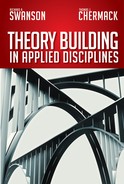PART ONE
Foundations of Theory Building
1 To Hell with Gravity
2 Foundations and Definitions of Theory Building
3 General Method of Theory Building in Applied Disciplines
MOST APPLIED DISCIPLINES are stuck because they have not connected sound theory and practice. They need to be advanced. Keep the following points in mind when thinking about theory in applied disciplines:
• Theory building defines a specific realm of knowledge and explains how it works.
• Applied disciplines are realms of study and practice that are fully understood through their use in the functioning world—such as management, organization development, public administration, marketing, highway engineering, leadership, and nursing.
Practitioners typically throw anything and everything at practical problems, while scholars often slice problems into such small segments that practical understanding is severely limited. Another almost fruitless approach is to try to emulate successful practitioners (e.g., Steve Jobs and Jack Welch) in hopes of replicating their performance. These tactics do not yield useful outcomes, and applied disciplines do not grow or advance as a result.
Comprehensive and rigorous theory building demands that problems and realms of practice are examined from a comprehensive perspective. In other words, applied disciplines severely falter when either concepts or practice dominates. A framework is needed to bring balance to theory and practice in applied disciplines. The General Method of Theory Building in Applied Disciplines can integrate theory and practice when working in complex situations. Theory building can start with new ideas (on the theory side) or in practice (on the applied side). The unique contribution of the General Method of Theory Building in Applied Disciplines is precisely the ability to accommodate a variety of starting points for theory development work. Embracing and integrating the dynamic interplay between developing ideas and using them is the key to growing and advancing applied disciplines.
Part One of this book lays out the need for theory building, as well as definitions and the background required to engage in theory-building content. The three chapters to Part One provide a working knowledge of theory building in applied disciplines.
Chapter 1, “To Hell with Gravity,” sets the stage for theory building. We describe the current state of theory building and make the case for developing better theorizing tools. The need for theory building is established, noting that we can do it better than the current efforts.
Chapter 2, “Foundations and Definitions of Theory Building,” summarizes the major points in theory-building content, including definitions, philosophical orientations, research paradigms, types of theories, and other content necessary as background material. This chapter establishes key ideas that are elaborated upon throughout the book.
Chapter 3, “General Method of Theory Building in Applied Disciplines” (contributed by Susan A. Lynham), presents a framework that is the basis for laying out the details of theory building. This chapter highlights the five major phases of theory building: Conceptualize, Operationalize, Confirm, Apply, and Refine.
The three chapters of Part One work together to provide the rationale, need, and concepts for engaging in the important work of theory building. A common language is developed for those interested in taking on theory-building projects as well as the five-phase framework for organizing the remaining chapters.
